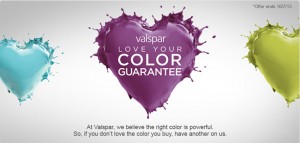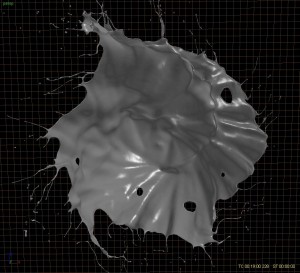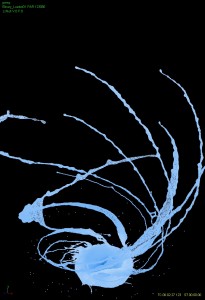Valspar Commercial: http://www.fusioncis.com/press/Valspar_halfHD.mov
When Shilo, NYC, approached Fusion CI Studios to create some highly art-directed, abstract fluid behaviors for a Valspar paint commercial, we jumped at the chance to work with their highly creative team. The concept was a unique, beautiful and extremely challenging performance for fluid simulations, which had to blend together believably with practical paint. The kind of effect Shilo was looking for has not been done before in RealFlow, so it was an opportunity to once again push the bounds of the software in an endeavor that was more performance-art for cg fluids than any commercial we’ve ever worked on.
In this spot, droplets of paint fall through air from a paint brush, colliding in mid-air to create splashes of paint that then morph into complex spiralling shapes, again colliding in mid-air to reform into a droplet which falls with a delicate splash into a paint can.
Heart Morph
The .15 second spot required a descending paint droplet to morph into a heart shape, the icon symbol of the spot, with trailing tendrils and droplets, then re-morph into a paint droplet which then cut with a practical droplet splashing into a bucket of paint.
The main challenge of this effect was that the fluid simulation was forced to perform in quite unnatural ways to meet the creative, yet still had to look as “organic” and realistic as possible, as if it really was a drop of paint falling through air, colliding with other droplets in space and ultimately forming a heart with lovely tendrils and droplets trailing behind.
To create this effect, the Fusion team opted to simulate the fluid motion, not actually falling through space, but sitting in place and behaving as though it was interacting with air-drag as it fell. The cg team at Shilo modeled geometry of the heart and animated ripples across the surface to meet the exacting creative desired by the client. Fusion’s team then morphed fluid to this geometry applying our smorganic tools to keep the fluid smooth and unbroken and the shape changed from a rounded droplet to the expanded heart form.
Movie of a heart morphing test: www.fusioncis.com/press/ValsparHeartMorphTest.mov
Movie of final heart morphing: www.fusioncis.com/press/Valspar_DropToHeartMorph.mov
Fusion also developed a scripted droplet generator which created additional fluid within the morphed fluid that was permitted to “leak” out of the heart under a specific set of forces that emulated the effects of air-drag. The droplet methodology had to be controllable enough to allow the Fusion artists to paint on locations of droplets and also to control very specifically the lengths of the tendrils before the pulled apart and got pulled away vertically into space.
Droplet Impact
For the .30 second spot, the creative was even more complex and beautiful. This version introduced a third challenging effect — 2 droplets would collide in space, merging upon impact, swirling outward to form a concave downward umbrella structure which would then burst apart in a controllable way. Don’t try this at home. The original intent was to shoot this practically. This is a great example of where cg can really help in these kinds of spots where control and specific art-direction is needed. If you imagine how hard it would be to shoot 2 tiny droplets of paint at each other and hit each other in an aesthetically appealing way, you see the crux of the problem. Never mind trying to get all the other exotic behaviors that happen after the collision. To create this effect, Fusion created 2 droplets of fluid and was able to do a precision launch of the droplets so they’d impact in a very precise way, just off center from each other. This meant that the initial impact could be designed to create a splash that was already flattened and oriented in the direction of a vortex force field.



Movie of a “droplet impact” test: www.Fusioncis.com/press/Valspar_DropletImpact.mov
The team then used an adapted version of the vortex force field developed for the tentacle swirl above so that we could swirl the fluid outward and then instead of pulling tentacles upward, we pulled the edges of the entire swirling sheet downward to give us and umbrella like shape. We then scripted an add-on to our “smorganic” toolset, allowing us to paint specific spots on the fluid sheet where tiny explosive forces would happen momentarily to burst the fluid away from those points and generate the explosive degradation of the fluid sheet. And finally, we used our standard smorganic tool to paint on locations on the margins of the sheet
to generate tendrils and droplets. Once everything was put together, the overall effect was both very natural looking and quite spectacular.
Final droplet Impact movie: www.fusioncis.com/press/Valspar_DropletImpact.mov
Droplet Swirl
For the next shot, “droplet swirl,” the Fusion team had to create an animated, mid-air sculpture essentially. It was clear from the beginning that the only way to approach this was to abandon the native set of tools for forces in RF and build from scratch a force field that would sculpt the fluid into the shapes and the motion required by the creative. The fluid needed to form a swirling vortex that would develop a set of arms or tentacles that would stretch outward then upward, spiraling around the center the entire time. Fortunately, Fusion has its smorganic tool set which would prevent fluid from breaking up and allow us to add on droplets and tendrils coming off the margins of the tentacles, so it was really just a matter of creating a force field that would pull the fluid into a “tentacley” shape. Easy, right?! Fusion’s team set about designing a custom vortex field where we could use key framed curves as mappings to horizontal distance from the center of the vortex and vertical distance above the vortex.
Early test of the collision /swirling/ reintegrating www.fusioncis.com/press/ValsparDropSwirlTest.mov
Final images, swirling droplets, from Valspar Commercial
This gave Fusion’s artists an extreme level of control in the character of the swirl above and radially away from the center of the droplet. Next, to create the tentacles, we introduced a sub population of particles which would have a controllable variation on the vortex force-field strength. And we created a method where we could paint on the areas where these particles would be selected.
So basically, where we painted on the fluid, those particles would have stronger vortex forces applied to them and they would pull away from the rest of the fluid, forming tentacles. Getting the variations in the tentacles was a matter of having painted on the particles which gave us a high level of control so that when the creative director let us know that the tentacles needed to be wider, narrow, or have more variation in size, we could implement the changes in a straightforward way.
In the actual spot, the tentacles had to spin out, away and up. And then with time, merge into a central tail above the droplet. This was a matter of changing with time the vortex forces on the tentacles and droplets. Finally, two of these
Final Droplet Impact Movie: www.fusioncis.com/press/Valspar_Dropletswirl.mov
‘tentacle swirls’ had to be right beside one another and then toward the end of the shot, collide and merge together in a highly appealing way. Rather than trying to have this happen by true physical interaction which would have broken up the sculptural look, the team chose to take 2 different sims of the swirls, animate the particle sets in space to come together at the same spot, and then meshed the two particles sets together to create the effect of the merging droplets.
This project is a great example of technology serving art-direction. In all the shots, Fusion had to build-up and evolve tools to address the creative target. It was tempting at various points to surrender to what seemed like technical limitations, but instead our client gave us space to work and we could re-approach the problems, eventually leaping over the technical barriers — sometimes the answers were simple once figured out, sometimes much more involved. It’s also a good example of how to build your tools. Always be thinking in terms what the client is likely to want in terms of changes, and then take the extra hour or hours to build in the controls that’ll let you revise easily. That approach paves the way for relatively painless revisions and releases, rather than straight-jacketing the creative process. After doing all that, it’s of course great to have a really strong end-game team to hand off the fluid assets, who could then create beautiful lighting and compositing; editing it all together to make an eye-popping result — our hats off to the Shilo team!
The finished spot: http://www.fusioncis.com/press/Valspar_halfHD.mov







